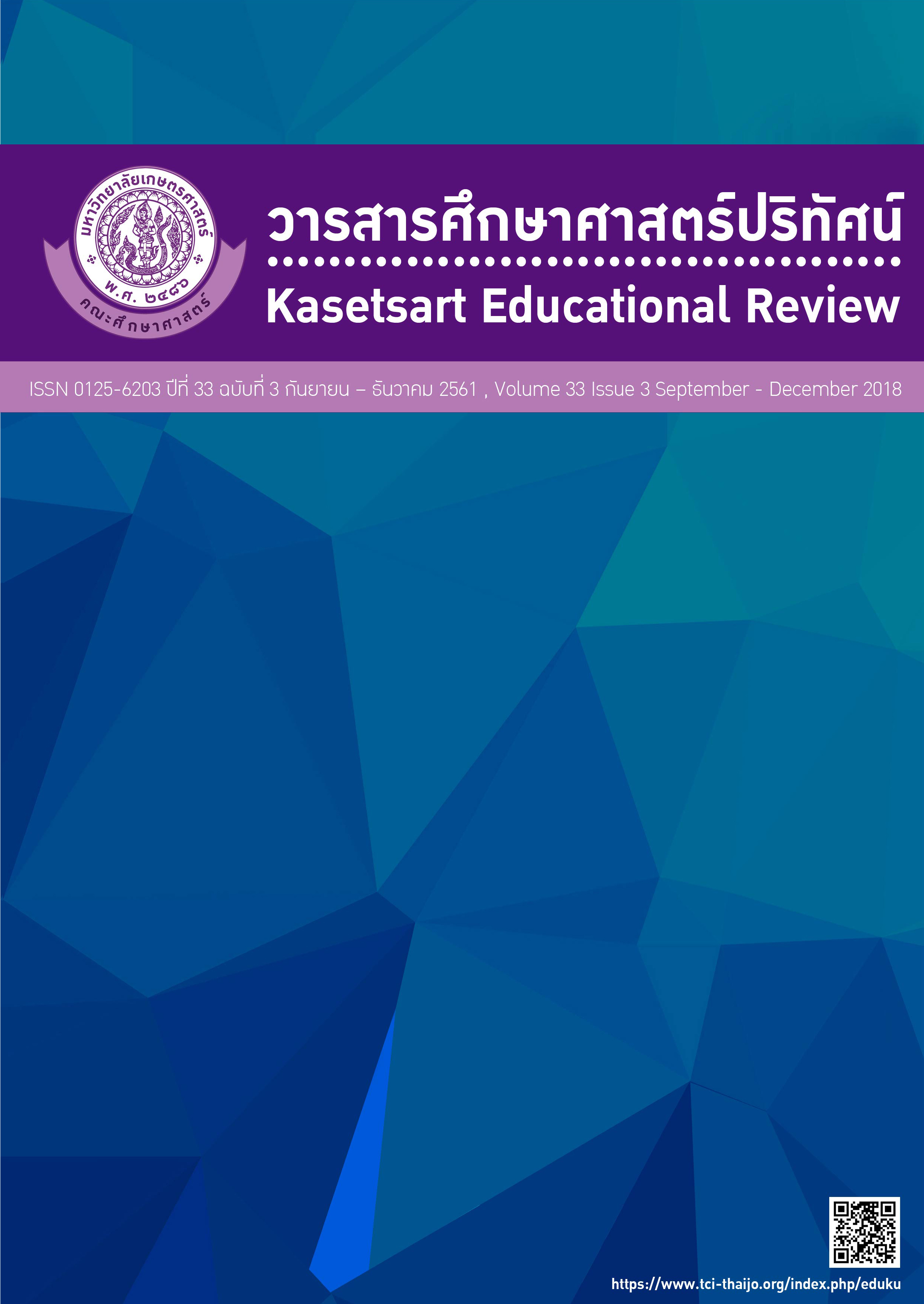การพัฒนาความคิดสร้างสรรค์ทางวิทยาศาสตร์ของนักเรียนชั้นมัธยมศึกษาปีที่ 6 โดยการจัดการเรียนรู้ตามแนวคอนสตรักชันนิซึม เรื่อง ระบบประสาท
คำสำคัญ:
ความคิดสร้างสรรค์ทางวิทยาศาสตร์, การจัดการเรียนรู้ตามแนวคอนสตรักชันนิซึมบทคัดย่อ
การวิจัยครั้งนี้มีวัตถุประสงค์เพื่อพัฒนาความคิดสร้างสรรค์ทางวิทยาศาสตร์ ด้วยการจัดการเรียนรู้ตามแนวคอนสตรักชันนิซึมเรื่องระบบประสาทและศึกษาแนวทางการจัดการเรียนรู้ตามแนวคอนสตรักชันนิซึมที่ใช้พัฒนาความคิดสร้างสรรค์ทางวิทยาศาสตร์ กลุ่มที่ศึกษาคือนักเรียนชั้นมัธยมศึกษาปีที่ 6 จำนวน 27 คน ผู้วิจัยใช้แผนการจัดการเรียนรู้ตามแนวคอนสตรักชันนิซึมที่เน้นพัฒนาความคิดสร้างสรรค์จำนวน 6 แผน และเก็บข้อมูลด้วยแบบวัดความคิดสร้างสรรค์ทางวิทยาศาสตร์ โดยวัดก่อนและหลังการจัดการเรียนรู้ และบันทึกหลังสอนเพื่อใช้เก็บข้อมูลแนวทางการจัดการเรียนรู้ วิเคราะห์ข้อมูลจากการประเมินเป็นรายคนแล้วหาค่าเฉลี่ยและส่วนเบี่ยงเบนมาตรฐาน และการวิเคราะห์ข้อมูลเชิงคุณภาพโดยการวิเคราะห์เนื้อหา ผลการวิจัยพบว่า ค่าเฉลี่ยของคะแนนความคิดสร้างสรรค์ทางวิทยาศาสตร์ของนักเรียนในช่วงหลังเรียนสูงขึ้นกว่าก่อนเรียนทั้งในด้านความคิดคล่อง ความคิดยืดหยุ่นและความคิดริเริ่ม แนวทางการจัดการเรียนรู้ตามแนวคอนสตรักชันนิซึมที่ใช้พัฒนาความคิดสร้างสรรค์ทางวิทยาศาสตร์ คือ การนำเข้าสู่บทเรียนควรเสริมกิจกรรมที่เน้นพัฒนาความคิดสร้างสรรค์ ที่มีความสอดคล้องกับเนื้อหาที่เรียนและ การมอบหมายชิ้นงานควรมีความแปลกใหม่สำหรับนักเรียน
เอกสารอ้างอิง
Chitrakorn, A. (2017). A Development of Collaborative Blended Learning Using Future Problem Solving Techniques to Promote Creativity in Graphic Design on Instructional Media of Pre-service Teacher Students Silpakorn University. Silpakorn University Journal ,37(1): 23-42.
De Bono, E. (1985). De Bono’s Thinking Course. London: Ariel Books.
Dhithjaroen, C. and Tanunchaibutra, P. (2014). The Development of Creative Thinking and Learning Achievment for Grade 12 Students By Using Project Learning Based on Constructionism Theory Programing of an Apply Robot Subject. Panyapiwat Journal, 5 (2): 205-216. [in Thai]
Jaroensettasin, T. (2017). Policy Focus Minister of Education. Retrieved from: http://www.moe.go.th/moe/ upload/news20/FileUpload /47695-6955.pdf, 18 September 2017. [in Thai]
Jittreechao, B., Kajornsin, B. and Lapanachokdee, W. (2017). The Development of Creative Thinking by Using the Creative Skills Practice on Computer Project Subject. Technical Education Journal King Mongkut’s University of technology North Bangkok, 8(1): 70-77. [in Thai]
Junthon, D. (2015). The Development of Grade 11 Students’ Scientific Creativity in the Learning Unit of Equilibrium Using 5E’s Scientific Inquiry Learning Approach. Master of Education (Science Education), Kasetsart University. [in Thai]
Kemmis, S. and McTaggart, R. (1988). The Action Research Reader (3rd Eds.). Geelong: Deakin University Press.
Moravesik, M.J. (1981). Creative in Science Education. Science Education. 65(2): 221-225.
Nuangchalerm, P. (2015). 21st Century Learning in Science. Journal of Rungsit University Teaching & Learning, 9(1): 136-154. [in Thai]
Pimthong, P., Soparat, S. and Chamrat, S. (2017). The Constructionist Paradigm shift of Teachers in 21st Century Learning. Kasetsart Journal of Social Science, 38(1): 470-481. [in Thai]
Sinrarat, P. (2014). Learning to the Future: 21st Century Challenge. Retrieved from: http://www.air.or.th/AIR /doc/Lectures27062557_07.pdf, 17 June 2017. [in Thai]
Sternberg, R. J. (1999). Handbook of Creativity. Cambridge University Press.
Techakosit S. and Piriyasurawong P. (2015). Constructionist Learning and Teaching Using Augmented Reality Technology for Science Subject. Technical Education Journal King Mongkut’s University of Technology North Bangkok, 6(1): 225-230 [in Thai]
Thongjun, N. and Pankaew, P. (2016). Development of Creative Thinking in Science of Lower Secondary Student Learning Through Brain Storming. Journal of Graduate Research, 7(1): 1-14. [in Thai]
Tonsakul, P. (2017). Educational Refrom Education 4.0 . Retrieved from: www.matichon.co.th/news/451872, 18 September 2017. [in Thai]
Torrance, E.P. (1987). Encouraging Creativity in the Classroom. Wm C. Brown Company publisher.
Wongchachom, P. and Cojorn, K. (2016). A Development of Creativie Thinking and Learning Achievement of Matthayomsueksa 5 Students based on the STEM Education Cooperated with Project-based Learning. Journal of Education Mahasarakham University, 10 (special): 463-474. [in Thai]
ดาวน์โหลด
เผยแพร่แล้ว
ฉบับ
ประเภทบทความ
สัญญาอนุญาต
บทความทุกบทความเป็นลิขสิทธิ์ของวารสารคณะศึกษาศาสตร์ มหาวิทยาลัยเกษตรศาสตร์ วิทยาเขตบางเขน
วารสารศึกษาศาสตร์ปริทัศน์ (Kasetsart Educational Review)






